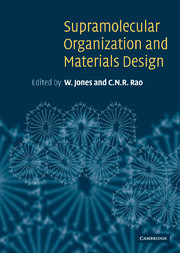Book contents
- Frontmatter
- Contents
- List of contributors
- Preface
- 1 Assembly and mineralization processes in biomineralization: strategies for forming biological composite materials
- 2 Mesoscale materials synthesis and beyond
- 3 Towards the rational design of zeolite frameworks
- 4 Mesoscale self-assembly: the assembly of micron-and millimeter-sized objects using capillary forces
- 5 Design of amphiphiles for the modulation of catalytic, membranous and gelation properties
- 6 Nanofabrication by the surface sol-gel process and molecular imprinting
- 7 The hierarchy of open-framework structures in metal phosphates and oxalates
- 8 Mesoscale self-assembly of metal nanocrystals into ordered arrays and giant clusters
- 9 Layered double hydroxides as templates for the formation of supramolecular structures
- 10 Molecular machines
- 11 Some aspects of supramolecular design of organic materials
- 12 Controlling crystal architecure in molecular solids: the supramolecular approach
- Index
5 - Design of amphiphiles for the modulation of catalytic, membranous and gelation properties
Published online by Cambridge University Press: 18 December 2009
- Frontmatter
- Contents
- List of contributors
- Preface
- 1 Assembly and mineralization processes in biomineralization: strategies for forming biological composite materials
- 2 Mesoscale materials synthesis and beyond
- 3 Towards the rational design of zeolite frameworks
- 4 Mesoscale self-assembly: the assembly of micron-and millimeter-sized objects using capillary forces
- 5 Design of amphiphiles for the modulation of catalytic, membranous and gelation properties
- 6 Nanofabrication by the surface sol-gel process and molecular imprinting
- 7 The hierarchy of open-framework structures in metal phosphates and oxalates
- 8 Mesoscale self-assembly of metal nanocrystals into ordered arrays and giant clusters
- 9 Layered double hydroxides as templates for the formation of supramolecular structures
- 10 Molecular machines
- 11 Some aspects of supramolecular design of organic materials
- 12 Controlling crystal architecure in molecular solids: the supramolecular approach
- Index
Summary
Introduction
Amphiphiles are molecules in which there exist a distinct polar segment and a lipophilic segment. Existence of segments of such opposing polarities makes these molecules self-organize upon solubilization in water in such a manner that the polar portion of these molecules remain exposed to water while the hydrophobic segments remain virtually buried [1]. Thermodynamically driven supramolecular aggregates of amphiphilic molecules, including those of natural origin (known as lipids), constitute some of the most widespread organizations in biological systems. These make up nearly 30–70% (by weight) of the components of the cell membrane, and are among the most intriguing type of self-assembly known [2]. The exceptional properties of amphiphilic molecules have, since the early development of chemistry, attracted the curiosity of many scientists, including those whose interests are at the interface of biology and materials science.
This chapter will present a few selected instances of design of synthetic amphiphiles including some from the author';s own laboratory that help in the understanding of various fundamental issues that pertain to the aggregation properties of these amphiphiles. Therefore rather than a review of the topic, this is an attempt to highlight certain recent developments involving designed molecular assemblies. References to review articles rather than to original papers are given wherever possible to limit the otherwise long list of references.
Catalyses and reactions in amphiphilic aggregates
Catalytic processes are part of modern strategies for the fast, inexpensive production of selective chemicals and are central to most modern chemical manufacturing industries.
- Type
- Chapter
- Information
- Supramolecular Organization and Materials Design , pp. 146 - 171Publisher: Cambridge University PressPrint publication year: 2001
- 1
- Cited by

